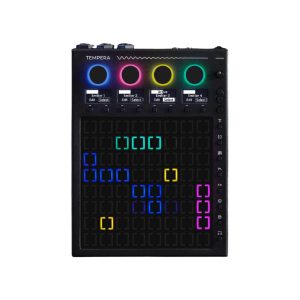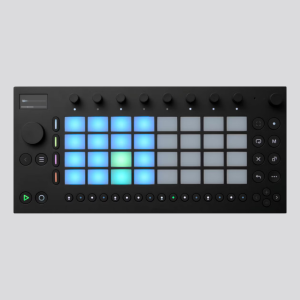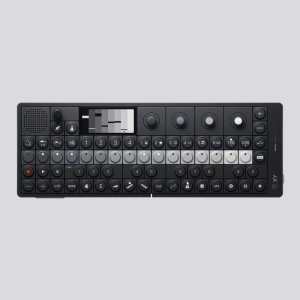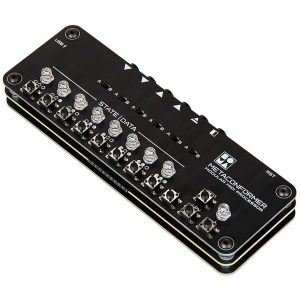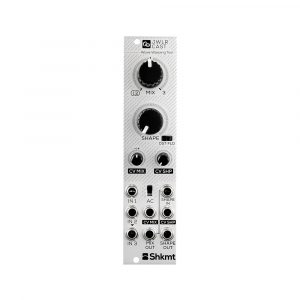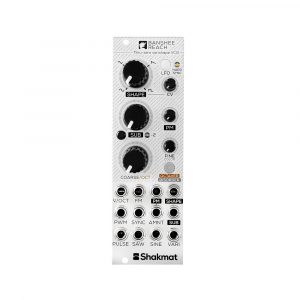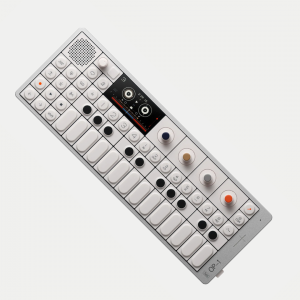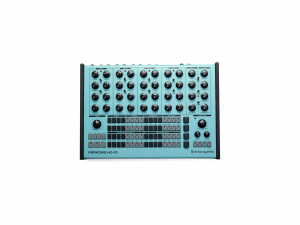The most recent addition to Moog’s line of semi-modular Eurorack synthesizers, the Moog Subharmonicon was originally revealed as part of an engineering workshop at Moogfest 2018. The device is inspired by elements of esoteric, early-1930s experimental instruments like the Mixtur-Trautonium and the Rhythmicon, and is similarly exploratory in nature. It’s premised on the concept of fundamental frequencies and sub-harmonics for chord generation, coupled with the use of mathematically corresponding, integer-based master clock divisions for complex, polyrhythmic pattern sequencing. The result is an instrument that’s uniquely suited to the deep, highly mutable exploration of harmony and rhythm, and a breath of fresh air for workflows reliant upon traditional step sequencers and pattern recording techniques.
The Moog Subharmonicon audio circuitry follows a fairly typical two-oscillator subtractive signal path, with the unique addition of two sub-harmonic generators for each oscillator. Three waveform options are available for each main oscillator: sawtooth, square, and a hybrid option that uses square for the fundamental and sawtooth for the sub-harmonics. Everything runs through a mixing stage to balance these sound sources (with distortion in the higher ranges), before going into a 24dB/octave low-pass ladder filter. There are attack-release envelopes for both the filter and VCA (ASR when a gate is applied and sustained), which can range from very snappy to about 10 seconds long (the filter also has some tricks up its sleeve). The Subharmonicon produces a generally warm and familiar Moog sound, with somewhat limited but satisfying tone shaping options. Its design allows for quick and effective taming of its generated frequencies into complex chord shapes, without lots of inter-module patching—a rare thing in the world of modular.
These chord shapes are sequenced by two four-step sequencers, which can drive the fundamental frequencies and/or sub-harmonics. While four steps might seem limiting, the sequencer is capable of generating longer, evolving sequences by applying these values to the different partials. With just the OSC button on, for instance, all three partials are affected together; with either of the SUB buttons on, the sequencer controls the integer used to divide the fundamental frequency, creating further sub-harmonics. These can (optionally) be quantized chromatically with equal or just temperaments, or diatonically with equal or just temperaments.
The two sequencers are driven by four rhythm generators, which are in many ways the irregularly beating heart of the device. These essentially apply polyrhythms to each sequence, derived from the master clock, with the pot settings determining the integer division used to generate each. Any combination of these polyrhythm generators can be used to drive either or both of the sequencers, and all can be individually addressed via CV. Finally, pitch CV inputs for both the fundamental frequencies and two of the subharmonics (as well as MIDI pitch control) means that external sequencers or MIDI controllers can seamlessly layer atop the sequencing options built into the device, making for even more complex melodic structures.
This all sounds like a lot, and at first glance the interface appears busier than those of the previous two devices in Moog’s family of semi-modulars, the Mother-32 and DFAM. But the design quickly starts to feel holistic and intuitive, and these conceptual complexities fall to the background as the flow state begins to take over. The controls have space to breathe, and small design touches—like the ability to hold the EG button to create a permanent gate, or manually “play” the trigger, reset and step advance functions with the appropriate button combos—allow for subtle improvisations. Taken together, all of these details make the Subharmonicon feel very much like a performative sequencing instrument; it excels at opening a recombinant, evolving dialogue between user and machine.
A telltale sign of good semi-modular design is this feeling of functioning as a “complete” instrument when used on its own, while opening up vast possibilities via its patchbay. This is indeed the case with the Subharmonicon; having dedicated outputs for both oscillators and sequencers, for instance, means that each can be processed with its own external envelope. Likewise, dedicated clock and pitch outputs for both sequencers means that the device can be used as a tool for composing and clocking other instruments in unique ways. While the patchbay is more oriented to these kinds of functions than sound shaping (which is primarily limited to PWM for each OSC, as well as filter cutoff), the inclusion of MIDI input provides some welcome additional flexibility (particularly the availability of attack and decay modulation via MIDI CC). Hopefully Moog will bring more MIDI functionality to the device via firmware updates, as currently this is limited to 11 parameters. Different playback modes for the sequencer—forward, backward, alternating and random—would also make nice firmware additions, as might the ability to chain the two sequencers together.
In typical Moog fashion, the entire Subharmonicon experience is framed by a thoughtful and well-designed manual, which is at once both a guide for using the device, and a sort of interactive history lesson in synthesis and electronics. Because of the Subharmonicon’s experimental nature (and its foundations in older instruments), the experience of learning and contextualizing is made particularly gratifying, charting the history of the ideas.
With its unique fusion of ideas and historical timelines, the Subharmonicon is a demonstration of a willingness on the part of perhaps the world’s most iconic synthesizer manufacturer to push boundaries. It’s not for everyone, but seems unlikely to disappoint the audience it will inevitably draw; by parameterizing so much of the note and rhythm generation, it’s uniquely suited to those who want to explore melodic shapes and phrases in a procedural but hands-on fashion. While other companies continue to mine its long history of synthesizer designs and chase its signature sound, Moog is charting new territory through under-explored synthesis techniques of electronic instruments older than even itself.
